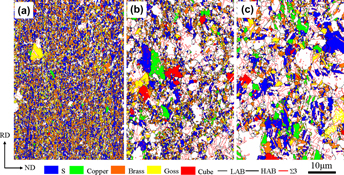Article contents
Evolutions of the texture and microstructure of a heavily cold-rolled Ni9W alloy during recrystallization
Published online by Cambridge University Press: 03 May 2016
Abstract

Texture and microstructure evolution during recrystallization of a heavily cold-rolled Ni9W alloy were investigated using x-ray diffraction and electron back-scattered diffraction. Brass, S and random orientations dominated the recrystallization process because the fractions of cube, Copper, and Goss orientations were low. Nearly all of the Brass and a part of the S orientation were consumed during recrystallization. Some of the S orientation was recrystallized grains, which grew during annealing and remained after the primary recrystallization. A large number of grains with other random orientations were formed as they had a significant size and fraction advantage during recrystallization. The evolution of microstructure and texture during recrystallization demonstrated that the cube grains did not have a size advantage compared with the noncube grains, which lead to the formation of a rough recrystallization cube texture in the Ni9W alloy after annealing.
Keywords
- Type
- Articles
- Information
- Copyright
- Copyright © Materials Research Society 2016
References
REFERENCES
- 7
- Cited by



